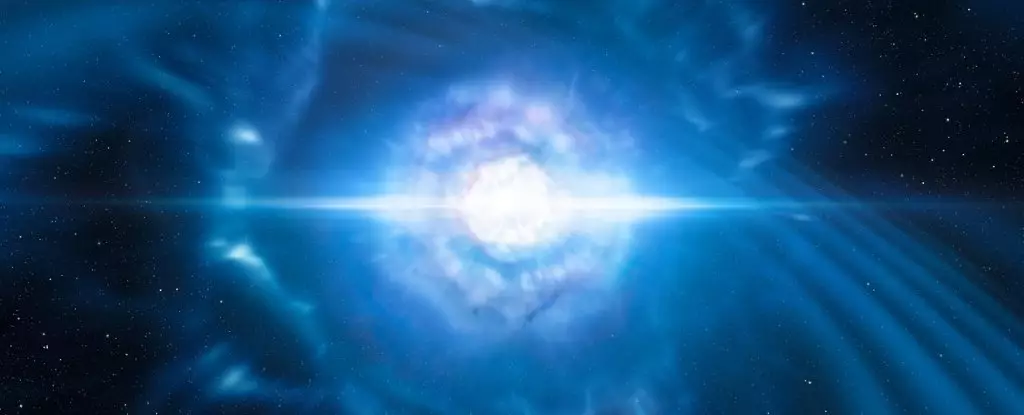In August 2017, the universe unfolded an extraordinary spectacle to humanity’s watchful eyes—a monumental collision of two neutron stars. This cataclysmic event, observed through an international array of telescopes, marked a seminal moment in astrophysics, revealing the merging of these cosmic giants and giving birth to a phenomenon called a kilonova, cataloged as AT2017gfo. The gravitational waves generated from the merger acted like cosmic ripples, alerting observatories on Earth and in orbit. Six years later, the extensive data collected from this single event continues to provide rich insights into the universe’s workings, particularly concerning the origins of heavy elements.
Astrophysicist Albert Sneppen and his research team from the Niels Bohr Institute at the University of Copenhagen have diligently analyzed the aftermath of the AT2017gfo event, revealing the dynamic evolution of the kilonova explosion. Sneppen emphasizes the complex and rapidly changing nature of this cosmic event, which unfolded over several hours. The challenge in comprehending such transient phenomena lies in the obstruction posed by Earth’s rotation, which limits the observational windows of any single telescope. However, the researchers embraced the intricate nature of the problem, combining datasets from various observatories in Australia, South Africa, and the Hubble Space Telescope.
By synthesizing this heterogeneous collection of data, they managed to reconstruct the kilonova’s evolution in unprecedented detail. This multidisciplinary approach throws into sharp relief the synergy between various observations, demonstrating that collectively they reveal far more profound information than any individual data set. The extensive nature of these collaborative efforts allows for a clearer narrative about this cosmic event, akin to compiling a vast tapestry where each thread contributes to a richer picture.
One of the most mesmerizing aspects of previous observations of AT2017gfo was its role as a laboratory for creating heavy elements. While the fusion processes occurring within stars can produce elements up to iron, heavy elements like gold and platinum require more energetic events for their creation. The neutron star merger revealed itself as an extraordinary factory for these heavy elements—specifically, r-process elements. The observations indicated the presence of strontium and yttrium in the explosion’s light signature, reinforcing earlier hypotheses that kilonovae are significant contributors to the elemental makeup of our universe.
Further investigations by Sneppen’s team unveiled the minute details of the explosion. Initially, the environment was staggering in temperature, reaching billions of degrees—almost comparable to the conditions during the Big Bang. In this extreme state, electrons and other fundamental particles buzzed freely, unbound from atomic nuclei. As the kilonova expanded and cooled, conditions stabilized, allowing particles to coalesce into the first atoms, a process reminiscent of an epoch early in the universe’s history known as the Epoch of Recombination.
The significance of this comparison cannot be understated. Approximately 380,000 years following the Big Bang, the universe obtained sufficient coolness to enable the formation of stable atoms from the primordial plasma. This cooling allowed light to finally traverse the cosmos, revealing a universe that had previously been opaque. The kilonova’s afterglow mimics this critical period, providing scientists with an analog through which they can study cosmic evolution on a smaller scale, offering valuable insights into the early universe’s atmospheric conditions.
The work of researchers like Sneppen and astrophysicist Rasmus Damgaard pushes the boundaries of our understanding, allowing us to witness the moment atoms are formed from their basic components. This close-up observation sheds light on the various elements’ birth and how they came together, reinforcing the critical role kilonovae play in the grander narrative of cosmic existence.
This groundbreaking inquiry into kilonovae presents a dual opportunity for scientists: not only can they observe the real-time physics of element formation in astrophysical events, but they can also glean functional knowledge about the universe’s history. The findings suggest that phenomena like AT2017gfo can act as natural laboratories, bridging gaps in our understanding between the cosmic past and the present.
As we unveil the layered complexities of these magnificent events, science moves towards better comprehension and respect for the universe. The ongoing investigation into events such as neutron star collisions builds a continuum of human inquiry into where we come from—pointing to a profound truth: the universe itself is perpetually creating and transforming, often in ways we have yet to fully appreciate.

